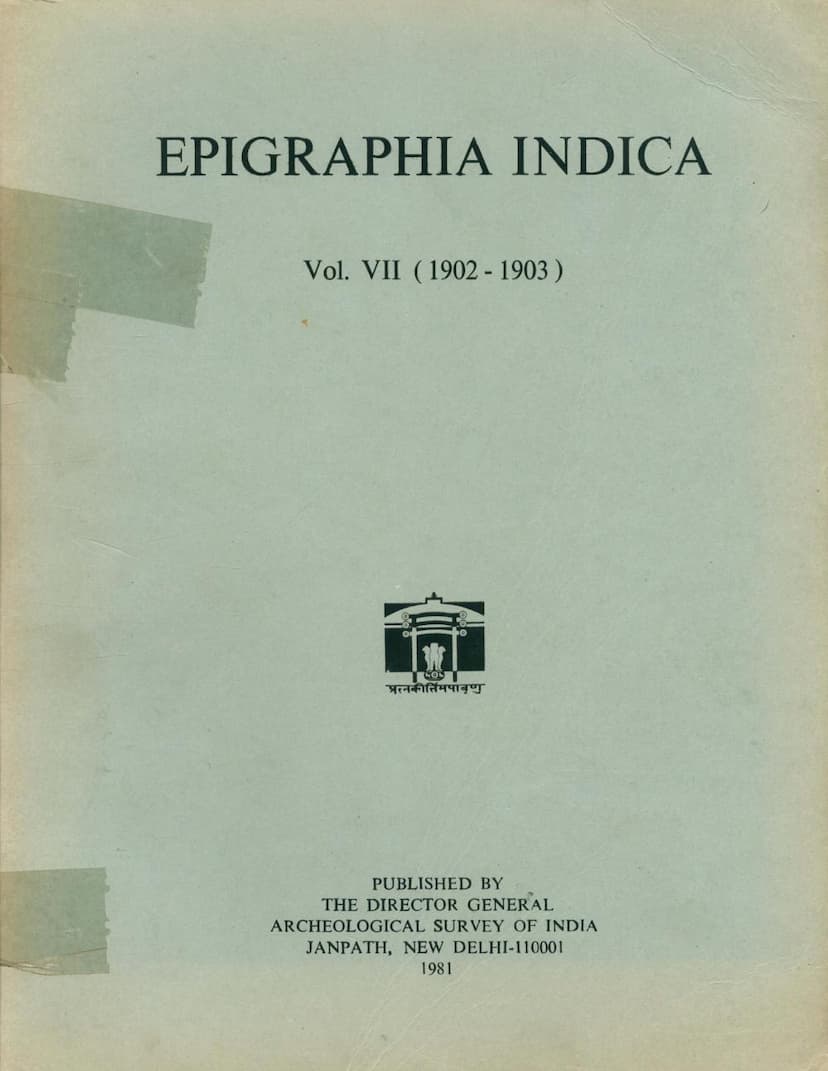Epigraphia Indica Vol 07
Added to library: September 1, 2025

Summary
This document is Volume VII of Epigraphia Indica, published by the Archaeological Survey of India. It contains a collection of inscriptions from various regions and periods of Indian history, edited by E. Hultzsch and other scholars. The volume focuses on deciphering and interpreting historical records found on stone and copper plates, providing valuable insights into the political, social, and religious landscape of ancient and medieval India.
The volume includes several inscriptions related to Jainism, particularly those found on the colossal Jaina images of Southern India (No. 14). These inscriptions offer details about the kings, ministers, and religious figures associated with Jainism, as well as the historical context of their patronage. The book also contains inscriptions related to other religious traditions, such as Hinduism and Buddhism, reflecting the religious diversity of ancient India.
A significant portion of the volume is dedicated to the study of South Indian dynasties, including the Cholas, Pandyas, and Rashtrakutas. The inscriptions shed light on their reigns, conquests, administrative practices, and genealogical accounts, helping to reconstruct the historical timeline of these powerful kingdoms. The volume also includes a comprehensive appendix listing dated inscriptions from Southern India, which serves as a valuable resource for researchers in Indian history and epigraphy.
The following specific inscriptions are highlighted in the provided text:
Chola Dynasty:
- Parantaka I: Dated to his 28th year, recording a gift of lamps by a queen.
- Rajendra-Chola I: Dates from his 31st year and 15th year are analyzed, with discussions on astronomical and textual discrepancies.
- Kulottunga-Chola I: Includes dates from his 16th and 3rd years, with astronomical calculations to verify their accuracy.
- Vikrama-Chola: Several inscriptions are analyzed to determine the precise start of his reign, with detailed discussions on calendar calculations and potential errors in original texts.
- Kulottunga-Chola III: Dates from his 3rd and 17th years are presented, with attempts to correct discrepancies.
- Rajàrâja III: Several inscriptions are dated, narrowing down the period of his reign's commencement.
- Rajendra-Chola III: Dates from his 3rd and 7th years are analyzed, suggesting a commencement of his reign between AD 1246 and 1253.
Pandya Dynasty:
- Vira-Pandya: Dates from his 7th and 15th years are discussed, helping to establish the commencement of his reign between AD 1252 and 1253.
- Maravarman Parakrama-Pandya: Dates from his 6th and 18th years are analyzed.
- Jatavarman Parakrama-Pandya: A date from his 15th regnal year is discussed.
- Jatilavarman Parakrama-Pandya Arikesardeva: Several dates are analyzed, placing the commencement of his reign between AD 1422 and 1453.
- Jatilavarman Parakrama-Pandya Kulasekhara: A date from his 20th regnal year is analyzed.
- Jatilavarman Srivallabha: Dates from his 3rd year suggest the commencement of his reign between AD 1534 and 1535.
- Maravarman Sundara-Pandya: A date from his 24th year is discussed.
- Jatilavarman Srivallabha Ativirarama: A date from his 5th regnal year is analyzed.
Other Significant Inscriptions:
- Cambay Plates of Govinda IV. (Saka-Samvat 852): This inscription provides a detailed genealogy of the Rashtrakutas and discusses the reign of Govinda IV., his military exploits, and his financial activities. It also delves into the meaning of certain terms and the history of the Rashtrakuta family name, offering insights into the evolution of script and language.
- Amaravati Inscription of Krishnaraya of Vijayanagara (Saka-Samvat 1437): This inscription is of significant historical value as it provides the first epigraphical record of Krishnaraya's military exploits, including the capture of important forts and the defeat of Virabhadra, the son of the Gajapati king. It also discusses the historical context of these events, drawing from Portuguese accounts and local chronicles.
- Three Jaina Colossi Inscriptions (Southern India): These inscriptions provide information about the commissioning of these colossal statues by Chamundaraja and Gangaraja for the Jaina saint Bahubali. They also touch upon the history and the evolution of the scripts used in the region.
- Madhuban Plate of Harsha (Year 25): This inscription is a charter of King Harsha of the Vardhana dynasty, detailing a land grant and providing insights into the administrative structure of his empire.
- Kahla Plate of Sodhadêva (Vikrama-Samvat 1134): This inscription details the genealogy of a previously unknown branch of the Kalachuri family and records a land grant made by Sodhadêva. It also provides information about various officials and administrative terms of the period.
- Lucknow Museum Plate of Kirtipála ([Vikrama-]Samvat 1167): This inscription belongs to Kirtipala of the Uttarasamudra kingdom and records a land grant made to a Brahman. It also offers details about the scribe and engraver of the record.
- Fourteen Inscriptions at Tirukkôvalûr: These inscriptions provide a range of information about the reign of the Chola kings Rajaraja III. and Kulottunga III., including the political situation in the region, the military exploits of their feudatories, and details of temple endowments.
- Kaluchumbârru Grant of Vijayaditya-Amma II.: This record details the grant of land to a Jain teacher, Arhanandin, for the maintenance of a Jain temple. It also discusses the history and nomenclature of the region, as well as the evolution of the script.
- Brahmi and Kharôshthi Rock-Inscriptions in the Kangra Valley: These inscriptions, dating from different periods, offer insights into the linguistic and paleographic evolution of ancient Indian scripts and shed light on the early history of the region.
- Other Inscriptions: The volume also includes numerous other inscriptions related to various dynasties and periods, providing a rich tapestry of historical information.
The publication also includes an extensive index by V. Venkayya and a crucial appendix listing dated inscriptions from Southern India, meticulously compiled by F. Kielhorn, which serves as a foundational reference for scholars in the field. The reprinted version includes corrections and additions, enhancing its value as a comprehensive source.
In essence, Epigraphia Indica, Volume VII, is a scholarly compilation of epigraphical records that significantly contributes to the understanding of ancient and medieval Indian history, highlighting the political landscape, religious practices, and linguistic developments of the time.